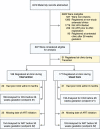An augmented SMS intervention to improve access to antenatal CD4 testing and ART initiation in HIV-infected pregnant women: a cluster randomized trial
- PMID: 25693050
- PMCID: PMC4334487
- DOI: 10.1371/journal.pone.0117181
An augmented SMS intervention to improve access to antenatal CD4 testing and ART initiation in HIV-infected pregnant women: a cluster randomized trial
Abstract
Background: Less than one-third of HIV-infected pregnant women eligible for combination antiretroviral therapy (ART) globally initiate treatment prior to delivery, with lack of access to timely CD4 results being a principal barrier. We evaluated the effectiveness of an SMS-based intervention to improve access to timely antenatal ART.
Methods: We conducted a stepped-wedge cluster randomized trial of a low-cost programmatic intervention in 20 antenatal clinics in Gaborone, Botswana. From July 2011-April 2012, 2 clinics were randomly selected every 4 weeks to receive an ongoing clinic-based educational intervention to improve CD4 collection and to receive CD4 results via an automated SMS platform with active patient tracing. CD4 testing before 26 weeks gestation and ART initiation before 30 weeks gestation were assessed.
Results: Three-hundred-sixty-six ART-naïve women were included, 189 registering for antenatal care under Intervention and 177 under Usual Care periods. Of CD4-eligible women, 100 (59.2%) women under Intervention and 79 (50.6%) women under Usual Care completed CD4 phlebotomy before 26 weeks gestation, adjusted odds ratio (aOR, adjusted for time that a clinic initiated Intervention) 0.87 (95% confidence interval [CI]0.47-1.63, P = 0.67). The SMS-based platform reduced time to clinic receipt of CD4 test result from median of 16 to 6 days (P<0.001), was appreciated by clinic staff, and was associated with reduced operational cost. However, rates of ART initiation remained low, with 56 (36.4%) women registering under Intervention versus 37 (24.2%) women under Usual Care initiating ART prior to 30 weeks gestation, aOR 1.06 (95%CI 0.53-2.13, P = 0.87).
Conclusions: The augmented SMS-based intervention delivered CD4 results more rapidly and efficiently, and this type of SMS-based results delivery platform may be useful for a variety of tests and settings. However, the intervention did not appear to improve access to timely antenatal CD4 testing or ART initiation, as obstacles other than CD4 impeded ART initiation during pregnancy.
Conflict of interest statement
Figures
References
-
- World Health Organization, UNAIDS, UNICEF (2009) Towards universal access: scaling up priority HIV/AIDS interventions in the health sector: progress report, November 2009. Geneva: World Health Organization, UNAIDS, UNICEF;
-
- Kesho Bora Study G, de Vincenzi I (2011) Triple antiretroviral compared with zidovudine and single-dose nevirapine prophylaxis during pregnancy and breastfeeding for prevention of mother-to-child transmission of HIV-1 (Kesho Bora study): a randomised controlled trial. Lancet Infect Dis 11: 171–180. 10.1016/S1473-3099(10)70288-7 - DOI - PubMed
-
- Kilewo C, Karlsson K, Ngarina M, Massawe A, Lyamuya E, et al. (2009) Prevention of mother-to-child transmission of HIV-1 through breastfeeding by treating mothers with triple antiretroviral therapy in Dar es Salaam, Tanzania: the Mitra Plus study. J Acquir Immune Defic Syndr 52: 406–416. 10.1097/QAI.0b013e3181b323ff - DOI - PubMed
Publication types
MeSH terms
Substances
Grants and funding
LinkOut - more resources
Full Text Sources
Other Literature Sources
Medical
Research Materials
Miscellaneous




